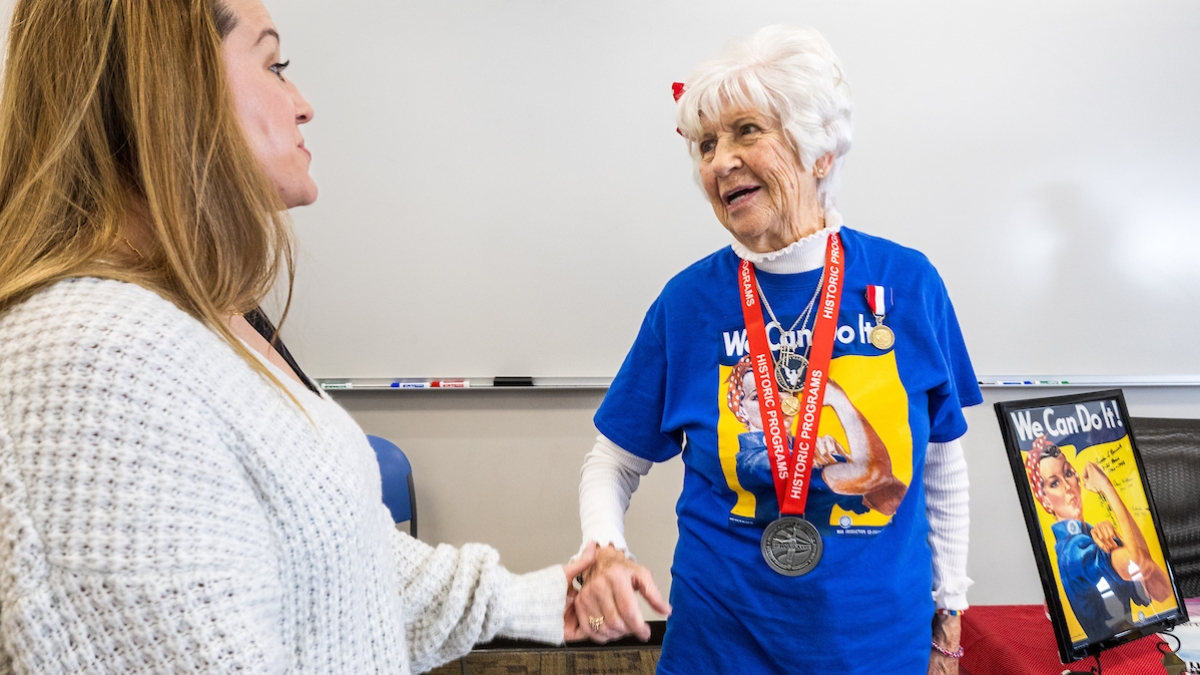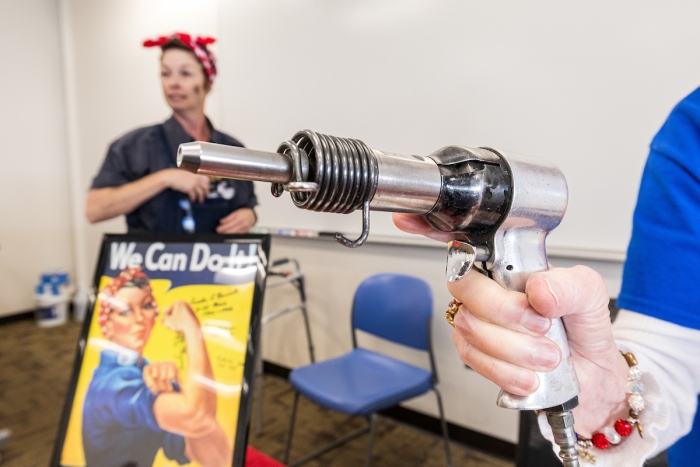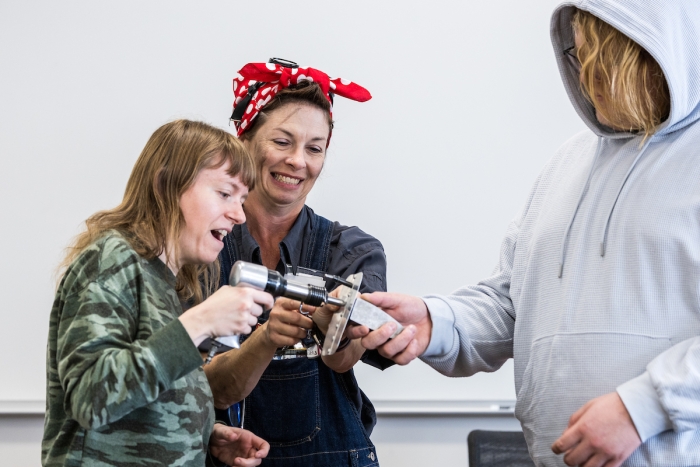A real-life Rosie the Riveter

An original Rosie the Riveter, Caroline Kilgore chats with former naval officer and nurse Vanessa Ronson after Kilgore's talk about being a teenager and working on aircraft wings after school during World War II. The talk was part of Teaching Professor Valerie Adams’ World War II history class Thursday, Feb. 15 on ASU's Polytechnic campus in Mesa. Photo by Charlie Leight/ASU News
Nothing beats learning about history directly from the source.
Caroline Kilgore was 17 years old when World War II broke out and she went to work as a “Rosie,” bucking rivets in the construction of fighter planes.
Today, she’s “97 and a half years old” and shared her experiences with Arizona State University history students on Feb. 15 as part of an aviation speaker series in the College of Integrative Sciences and Arts. The series draws on a large network of contacts in aviation and military-affiliated organizations in metro Phoenix and the East Valley to augment student learning.
“It was a trying time in America,” said Kilgore, a retired Sun City resident who made the 50-mile trek to ASU’s Polytechnic campus. “Everything was rationed — food, gas, sugar, cotton, aluminum and rubber. Morale was bad for three years. But everybody was doing their part and pitching in for the war effort.”
Kilgore was invited by Valerie Adams, a teaching professor in CISA’s School of Applied Sciences and Arts, to bring community knowledge to her HST 306: World War II history class.
“The government encouraged women to take defense jobs during the war, calling them a ‘hidden army’ in one film, in fact,” said Adams, who is also an affiliated faculty member in CISA’s Office for Veteran and Military Academic Engagement. “Caroline is one of those young women who stepped up when the country needed her, and that makes her a hero in my book. I want my students to hear her story from her — bringing the textbook to life, so to speak — and perhaps be inspired.”
Kilgore was a high school senior in Rockford, Illinois, when war was declared after the bombing of Pearl Harbor on Dec. 7, 1941. America was still reeling from the financial aftermath of the Great Depression, and the country was on its heels.
“We were so poor that we didn’t know we were poor, because the stock market took everything,” Kilgore said.
President Franklin Delano Roosevelt realized winning the war against the Axis powers meant a full commitment from all citizens — men, women and children.
It was a trying time for all, according to Kilgore. In addition to rationing, there were daily blackouts, buses were standing room only and materials for clothing were hard to come by. She sewed dresses from tablecloths and used parachutes, and she wore shoes made of cotton and cork. Some women, she recalled, painted their legs to resemble stockings.
Children participated in scrap drives — paper drives, metal drives, rubber drives and grease drives.
Women went to work in factories, the civil service and in the defense industry. Nearly 350,000 served in the U.S. armed forces, performing a variety of jobs. They labored as welders, machinists and riveters. They also drove trucks, flew planes, organized fundraisers, grew crops and took care of their children.
Westinghouse produced a series of posters as part of a national campaign to recruit women into the workforce. The most enduring image was that of Rosie the Riveter, a powerful woman dressed in denim overalls and a red bandana, who represented female patriotism.
Kilgore said the concept of women in the workforce was a quantum leap for many women in America in the 1940s, but they were willing to make the sacrifice.
“At that time, women did not wear slacks or shorts. They only wore dresses,” Kilgore said. “They took care of their children. They took care of their flower gardens. They went to PTA meetings and had dinner ready for their husbands when they came home from work. When the men went off to war, there was a demand for their jobs. Well, who was going to do that? Women!”
Kilgore went to work as a “Rosie,” bucking rivets on wings for the Douglas C-47 Skytrain, which was used for troop transport, paratrooper drops and military cargo transport drops. It was most famously used in Yugoslavia to bring home about 500 airmen who had been attacked and parachuted on their way to a mission in Romania.
“People in the Yugoslavian resistance movement protected them until the C-47s arrived,” said Adams, who earned her pilot’s license at age 17 and whose teaching and scholarship is focused on the impact of aviation in our lives for the past century.
Adams noted that according to Dwight D. Eisenhower, supreme commander of the Allied Forces in Europe during World War II, the four weapons that helped most to win the war were “the C-47, the Jeep, the bazooka and the atomic bomb.”
Making 75 cents an hour, Kilgore worked eight-hour shifts after school, changing buses twice to reach the Case factory that had manufactured farm machinery before the war. Sometimes she even hitchhiked to work.
Kilgore said her small size worked to her advantage, allowing her to work inside the wing, where she held the bucking bar for the riveter on the outside of the plane. The two communicated by tapping on the aluminum. Kilgore said not only was it grueling work, but it was also loud and isolating.
“My favorite part of the day was lunch time,” said Kilgore, who donned a one-piece coverall and a hair net for her factory job. “I really didn’t like my job, but it had to be done.”
The Rockford plant assembled 13 wings a day and more than 10,000 in a three-year period, according to Kilgore. She added that it was those sacrifices and the esprit de corps of the entire American population that helped the country and its allies to win the war.
When that day finally came, Kilgore said Rockford threw a parade.
“There was lots of hugging and kissing, but we didn’t have any rubber, so we had no confetti, we had no balloons,” Kilgore said. “But we did have feathered pillows. So, we tore them up, slit them open and let the feathers fly.”
She concluded that although the outcome was tipped in America’s favor, the cost and sacrifice were great.
“Freedom is not cheap — it’s not cheap. Some of the boys who were my classmates and 17 years old went off to war and never came back because they were anxious to save our country,” Kilgore said. “They went because they wanted to save America so we could have freedom. So think about what they have done for us.”
It was certainly food for thought for psychology major Lucy Peterson, who attended Kilgore’s presentation.
“I had been reading about the riveters and women in war, but she (Kilgore) made me realize how everything changed so quickly,” Peterson said. “Before the war, 80% of all women in the United States did not work outside the household. The war effort changed everything so fast.”
History major Zachary Mohrbacker said he enjoyed learning about both the history and personal sacrifice.
“She continued to do the job even though she didn’t like it,” said Mohrbacker, who will graduate in May. “If I didn’t like a job, I’d probably just quit and find another one. But for her, she kept doing it because she was supporting our country. She knew it was going to benefit the United States in the long run. So her persistence to keep working was really inspiring.”
Join in the learning
Next week, the public is invited to join Adams’ HST 319: History of Aviation course for a presentation on the history of “close air support” in the U.S. Air Force by retired Brig. Gen. Tom Webster, a former A-10 and F-16 pilot.
When: 12-1:15 p.m. Thursday, Feb. 22
Where: Santan Hall 131, ASU Polytechnic campus
Applied learning, emboldened by community collaboration
Adams said many of her sources for guest presenters come from her connections with her membership in the American Aviation Historical Society and her volunteer work with Arizona Commemorative Air Force Museum, in particular, where she has established an ongoing history internship placement for ASU Polytechnic campus history students, just a few miles up the road at Falcon Field.
“People talk about Phoenix being a magnet for retired professional athletes, and the same is true for retired pilots and military veterans, who got a taste of Arizona life stationed at Luke or Davis-Monthan air bases or right here at Polytechnic campus, the site of the former Williams Air Force Base, which as a pilot training base, saw waves and waves of service members come through,” Adams said.
“I know three people who chose to retire in the Valley just to be volunteers at the Arizona Commemorative Air Force Museum, which is one of the largest Commemorative Air Force units in the world.”
Adams met Kilgore through a modern-day “Rosie,” former airplane mechanic Alice Klobe, who volunteers her talents at the museum to keep its aircraft — including a C-47 — in tip-top shape. Klobe accompanied Kilgore on the Polytechnic campus visit Thursday and demonstrated with Adams’ students the tools and processes Kilgore would’ve used on the job. She came dressed in the bandana and overalls that she wears to invite questions from museum visitors about the Rosies of World War II.
“Caroline Kilgore’s presentation today as part of Valerie Adams’ aviation speaker series, as well as the ongoing internship partnership with the Commemorative Air Force Museum, showcase some of the ways our focus in the College of Integrative Sciences and Arts on applied learning is incorporated into the humanities,” noted Joanna Grabski, dean of the college, “and how we’re leveraging our place at the Polytechnic campus and the East Valley.”
More Arts, humanities and education

ASU professor's project helps students learn complex topics
One of Arizona State University’s top professors is using her signature research project to improve how college students learn science, technology, engineering, math and medicine.Micki Chi, who is a…

Award-winning playwright shares her scriptwriting process with ASU students
Actions speak louder than words. That’s why award-winning playwright Y York is workshopping her latest play, "Becoming Awesome," with actors at Arizona State University this week. “I want…

Exceeding great expectations in downtown Mesa
Anyone visiting downtown Mesa over the past couple of years has a lot to rave about: The bevy of restaurants, unique local shops, entertainment venues and inviting spaces that beg for attention from…



